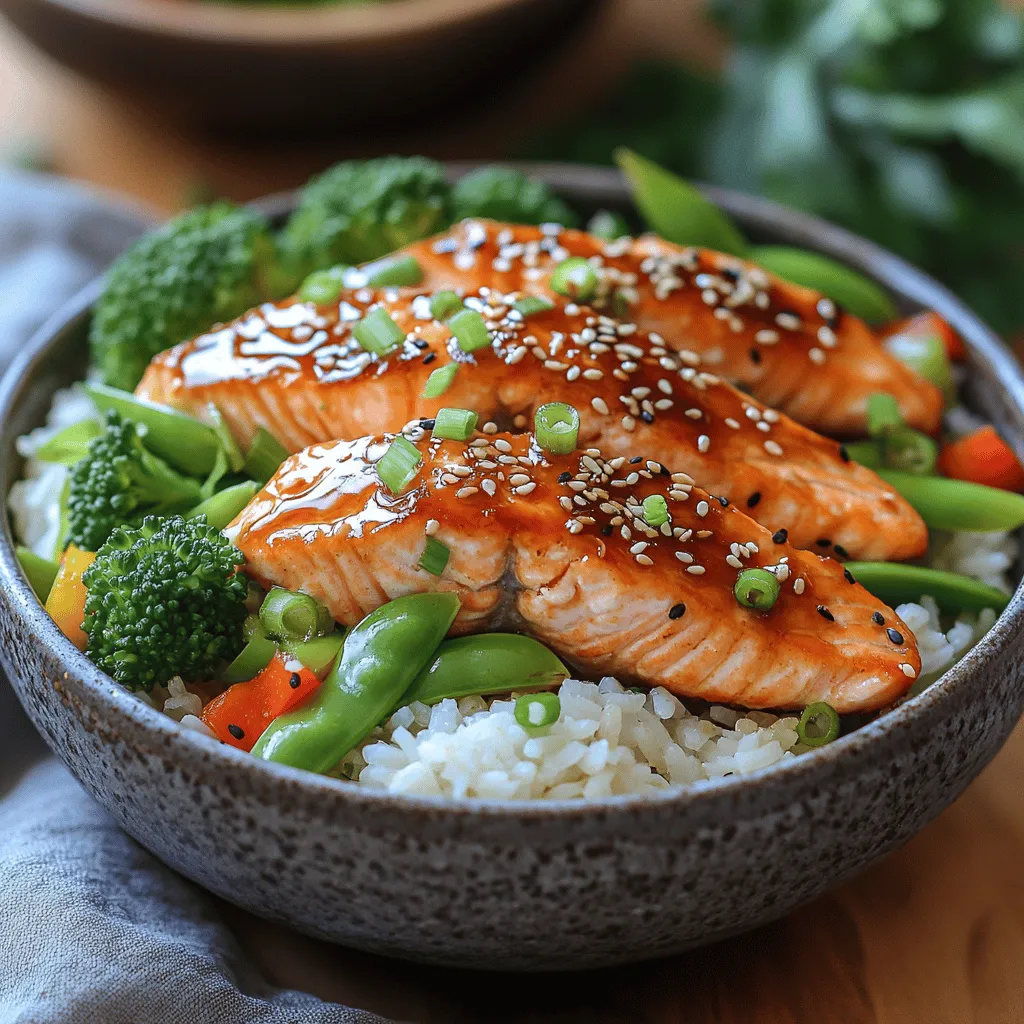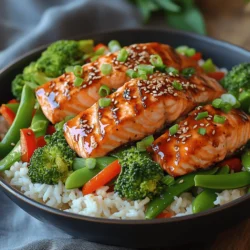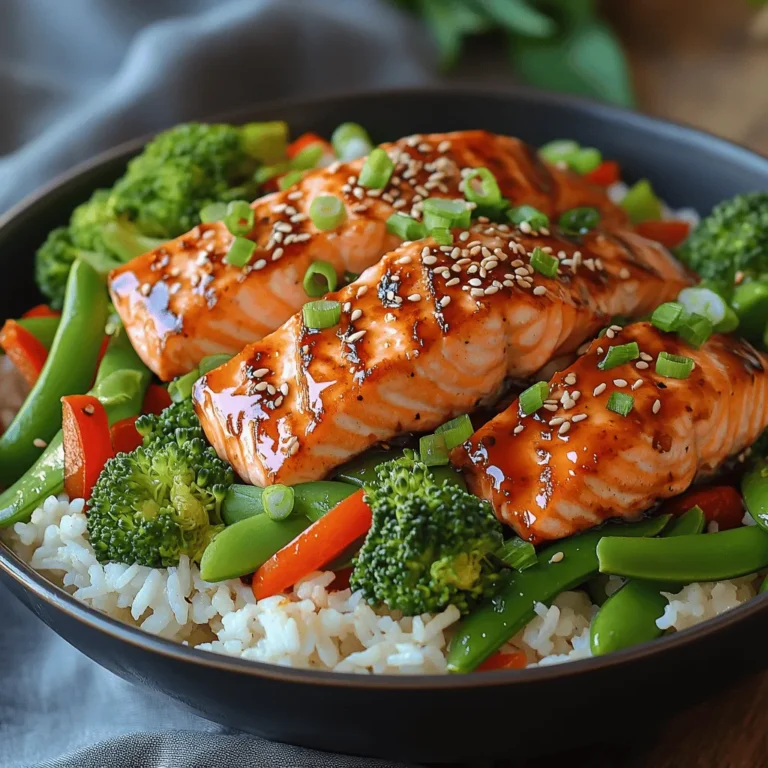In the realm of quick and healthy meals, the One-Pan Teriyaki Salmon & Veggie Rice Bowl stands out as a delicious and nutritious option that merges fresh ingredients with bold flavors. This dish not only tantalizes the taste buds but also caters to the needs of busy individuals seeking balanced meal solutions. With its quick preparation time, minimal cleanup, and wholesome ingredients, this recipe is a perfect fit for anyone aiming to maintain a healthy lifestyle without sacrificing flavor.
In today’s fast-paced world, the importance of easy and healthy meal options cannot be overstated. As more people strive to eat well while juggling work, family, and other commitments, recipes like the One-Pan Teriyaki Salmon & Veggie Rice Bowl offer a practical solution. This dish is designed to provide a balanced meal in under 30 minutes, making it an ideal choice for weeknight dinners or meal prep sessions.
Understanding the Ingredients
Health Benefits of Salmon
Salmon is a nutritional powerhouse, making it a star ingredient in this rice bowl. One of the most significant benefits of salmon is its rich content of omega-3 fatty acids. These essential fats are known for their heart health benefits, helping to lower blood pressure and reduce the risk of heart disease. Furthermore, salmon is an excellent source of high-quality protein, which is crucial for muscle building and repair, especially for those engaging in regular physical activity. Including salmon in your diet can also support brain health, due to its high levels of DHA (Docosahexaenoic acid), which is essential for cognitive function.
Exploring the Role of Teriyaki Sauce
Teriyaki sauce plays a pivotal role in this recipe, imparting a delightful flavor to the salmon. While you can easily find store-bought versions, making your own teriyaki sauce at home allows for greater control over the ingredients, particularly for those monitoring their sugar intake or sodium levels. Homemade teriyaki sauce typically includes soy sauce, mirin, sake, and sugar, resulting in a sweet-savory profile that enhances the salmon’s natural flavors. This versatility makes teriyaki sauce not only great for salmon but also excellent for chicken, tofu, and stir-fried vegetables.
Importance of Fresh Vegetables
The vibrant medley of fresh vegetables, including broccoli, red bell pepper, and snap peas, is essential to the One-Pan Teriyaki Salmon & Veggie Rice Bowl. Each vegetable contributes unique nutritional benefits. Broccoli is rich in vitamins K and C, fiber, and antioxidants, making it a great addition for overall health. Red bell peppers are known for their high vitamin A content and vibrant color, which not only enhances the dish’s visual appeal but also adds a sweet crunch. Snap peas provide a delightful texture and are packed with vitamins C and K, making them a nutrient-dense choice that complements the dish beautifully.
Preparation Steps Explained
Marinating the Salmon
Marinating the salmon is a crucial step that elevates the dish’s flavor profile. The marinade infuses the fish with the sweet and savory notes of the teriyaki sauce, ensuring each bite is bursting with flavor. For optimal taste, it’s recommended to marinate the salmon for at least 15 to 30 minutes. If time permits, letting it marinate for a couple of hours in the refrigerator can further enhance the flavors. To prepare the marinade, simply whisk together soy sauce, mirin, ginger, garlic, and a touch of honey or brown sugar, then allow the salmon fillets to soak in this mixture.
Cooking Jasmine Rice
Achieving perfectly fluffy jasmine rice is an art that can elevate the entire dish. Before cooking, it’s essential to rinse the rice under cold water to remove excess starch. This process helps to prevent the rice from becoming overly sticky and ensures a light, airy texture. The general rule of thumb for cooking jasmine rice is to use a 1:1.5 ratio of rice to water. Bring the water to a boil, then reduce to a simmer and cover. Allow the rice to cook undisturbed for about 15 minutes, then remove from heat and let it sit covered for an additional 5 minutes. This resting period allows the rice to steam and achieve that perfect fluffy consistency.
Sautéing Vegetables
Sautéing the vegetables is the final step in preparing this one-pan meal. Start by heating a tablespoon of oil in the same pan where the salmon will be cooked. The key is to ensure the oil is hot enough to create a slight sizzle when the vegetables are added. Begin with the broccoli, as it takes slightly longer to cook, followed by the red bell pepper and snap peas. Stir-fry the vegetables for just a few minutes until they are tender-crisp, retaining their vibrant color and nutritional benefits. This method not only enhances the flavors of the vegetables but also allows them to complement the teriyaki salmon beautifully.
This One-Pan Teriyaki Salmon & Veggie Rice Bowl is a testament to how easy it can be to prepare a healthy meal without sacrificing taste. With its combination of nutritious ingredients and simple cooking techniques, it’s a dish that anyone can master and enjoy.

Techniques for Achieving the Right Level of Tenderness and Vibrancy
When preparing a one-pan teriyaki salmon and veggie rice bowl, achieving the right texture and vibrant colors in your vegetables is essential for both flavor and presentation. Steaming or sautéing vegetables quickly over high heat ensures they retain their nutrients and crunch while developing a beautiful color. For instance, broccoli and bell peppers should be cooked just until they turn bright green or soft, but not mushy.
To enhance the tenderness of your veggies, consider blanching them briefly in boiling water before adding them to the pan. This technique helps to lock in their color and nutrients. After blanching, immediately transfer them to a bowl of ice water to halt the cooking process. This method keeps your vegetables vibrant and appealing while ensuring a satisfying crunch.
Flavoring Vegetables to Elevate Their Taste
Flavoring your vegetables can elevate the dish without overpowering the natural taste of the salmon. A simple technique is to sauté your vegetables in a splash of sesame oil or olive oil, adding a pinch of salt and a sprinkle of black pepper for seasoning. For added depth, consider incorporating garlic or ginger into the oil before adding your vegetables.
Another approach is to toss your veggies with a splash of low-sodium soy sauce or a hint of the teriyaki sauce used for the salmon. This creates a cohesive flavor profile throughout the dish and enhances the overall taste experience. Remember, the goal is to complement the salmon’s rich flavor, not to overshadow it.
Cooking the Salmon
Best Practices for Cooking Salmon to Achieve a Perfect Sear and Optimal Doneness
Cooking salmon to perfection requires attention to detail to achieve a golden-brown sear while ensuring the fish remains tender and moist inside. Start by patting the salmon fillets dry with a paper towel. This step helps to achieve a nice sear, as moisture can prevent the fish from browning properly.
Heat a non-stick skillet over medium-high heat and add a tablespoon of oil. Once the oil shimmers, carefully place the salmon fillets skin-side down. Allow them to cook undisturbed for about 4-5 minutes. This technique not only helps achieve a perfect sear but also allows the skin to crisp up nicely.
Once the skin is golden brown, gently flip the fillets and reduce the heat to medium. Brush the teriyaki sauce over the top of the salmon and continue cooking for an additional 3-4 minutes. The salmon is done when it flakes easily with a fork and has an internal temperature of 145°F (63°C).
Safety Tips for Handling Raw Fish and Avoiding Cross-Contamination
Handling raw fish safely is crucial to prevent foodborne illnesses. Always wash your hands thoroughly before and after handling raw salmon. Use separate cutting boards for raw fish and other ingredients, like vegetables or cooked foods, to avoid cross-contamination.
Keep the salmon refrigerated until you’re ready to cook it, and if you have any leftovers, store them in an airtight container in the refrigerator for no more than two days. Reheat the salmon to an internal temperature of 145°F (63°C) before consuming. Following these safety tips will ensure that your meal is both delicious and safe to eat.
Assembling the Perfect Bowl
Layering Techniques for Creating a Visually Appealing and Balanced Meal
The assembly of your teriyaki salmon and veggie rice bowl is just as important as the cooking process. Start with a base of perfectly cooked rice – whether white, brown, or jasmine – as it provides a neutral flavor that complements the other ingredients.
Next, artfully arrange the vegetables around the rice. For instance, place the broccoli and bell peppers in a colorful fashion, creating a rainbow effect. Finally, top the bowl with the salmon fillet, ensuring it stands out as the star of the dish.
Importance of Presentation in Enhancing the Dining Experience
Presentation plays a significant role in the dining experience. A well-assembled bowl not only looks enticing but also enhances the overall enjoyment of the meal. Investing a few extra minutes in presentation can elevate a simple dish to something special.
Consider using contrasting colors and varying shapes in your vegetable choices. For example, pairing the green of broccoli with the vibrant orange of bell peppers and the rich pink of salmon creates an appealing visual contrast. Additionally, serving the bowl in a larger, shallow dish can make the meal appear more generous and inviting.
Suggestions for Portion Sizes of Rice, Veggies, and Salmon
When assembling your bowl, keep portion sizes in mind to ensure a well-balanced meal. A general guideline is to use about one cup of rice as the base, one cup of mixed vegetables, and one salmon fillet (approximately 4-6 ounces) per serving. This distribution provides a satisfying meal without overwhelming the palate or the plate.
Garnishing Options
Role of Garnishes, Such as Sesame Seeds and Green Onions, in Flavor and Texture
Garnishing your dish not only adds flavor but also introduces texture and visual appeal. A sprinkle of toasted sesame seeds adds a delightful crunch and nutty flavor, while finely chopped green onions provide a fresh, sharp contrast.
Consider adding a drizzle of additional teriyaki sauce over the top before serving for an extra burst of flavor. A few slices of avocado or a dollop of sriracha can also enhance the dish, balancing richness with creaminess or heat, respectively.
Ideas for Additional Garnishes or Toppings to Personalize the Dish
Personalization is key to making the dish your own. Additional garnishes could include pickled ginger for a tangy contrast, cilantro for freshness, or crushed peanuts for added crunch. You might also consider a sprinkle of chili flakes for those who enjoy a bit of heat, or a touch of lime juice for a zesty finish.
Nutritional Analysis
Discussion of the Overall Nutritional Profile of the Dish
The teriyaki salmon and veggie rice bowl is not just delicious but also nutritious. Salmon is an excellent source of high-quality protein, omega-3 fatty acids, and essential vitamins and minerals, including vitamin D and selenium. The accompanying vegetables contribute a variety of vitamins, minerals, and fiber, making this dish a well-rounded meal option.
Caloric Breakdown per Serving and Nutrient Distribution
A serving of this teriyaki salmon and veggie rice bowl typically contains around 500-600 calories, depending on the portion sizes and specific ingredients used. The dish provides an excellent balance of macronutrients, with approximately 30 grams of protein, 50 grams of carbohydrates, and 20 grams of healthy fats, particularly from the salmon and any oils used in cooking.
Comparison with Other Common Meal Options in Terms of Health Benefits
When compared to common fast food options or processed meals, the teriyaki salmon and veggie rice bowl stands out as a healthier alternative. It is rich in essential nutrients, lower in unhealthy fats, and avoids the additives and preservatives found in many pre-packaged meals. This dish supports heart health, weight management, and overall well-being.
Dietary Considerations
Adaptability for Gluten-Free Diets by Using Appropriate Teriyaki Sauce
For those following a gluten-free diet, it is crucial to select a gluten-free teriyaki sauce. Many brands offer gluten-free options made with tamari instead of soy sauce, ensuring that this dish can be enjoyed without compromising dietary restrictions.
Suggestions for Vegetarian or Vegan Versions of the Dish
For a vegetarian or vegan version of the teriyaki bowl, consider substituting the salmon with tofu or tempeh. Both options can be marinated in the teriyaki sauce and cooked to achieve a similar flavor profile. Additionally, replace the rice with quinoa or cauliflower rice to maintain a light and nutritious base.
Conclusion
The one-pan teriyaki salmon and veggie rice bowl is a culinary gem that offers convenience, nutrition, and an explosion of flavor. With its vibrant colors and satisfying textures, it’s the perfect meal for busy weeknights or leisurely weekends.
This dish not only showcases the joy of cooking but also the satisfaction of preparing a wholesome meal right at home. We encourage you to try this recipe and experience the delight of creating a balanced, delicious bowl that family and friends will enjoy. Embrace the joy of cooking – it’s not just about the food, but the love and care that goes into every bite. Enjoy your culinary adventure!


